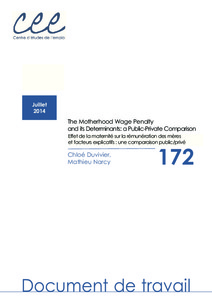The motherhood wage penalty and its determinants: a public-private comparison
"In this paper, we investigate whether public and private sector employees bear a different wage penalty from having children. Using data from the Families and Employers survey, we are able to address three potential biases: self-selection into employment, self-selection into sectors, and unobs...
| Main Authors: | , |
|---|---|
| Institution: | ETUI-European Trade Union Institute |
| Format: | TEXT |
| Language: | English |
| Published: |
Noisy-le-Grand
2014
CEET |
| Subjects: | |
| Online Access: | https://www.labourline.org/KENTIKA-19117473124919356559-The-motherhood-wage-penalty-an.htm |
| Summary: | "In this paper, we investigate whether public and private sector employees bear a different wage penalty from having children. Using data from the Families and Employers survey, we are able to address three potential biases: self-selection into employment, self-selection into sectors, and unobserved heterogeneity. We find that mothers of two or more children suffer from a much larger penalty when they work in the private sector. In addition, in both sectors, we find no unexplained penalty once we control for all the potential determinants of the family pay gap, namely, a reduced labour supply of mothers, child-related career interruptions, less access to management positions, and adjustments in working conditions. However, these factors play different roles in explaining the motherhood penalty in each sector; most notably, child-related career interruptions are much more harmful in the private sector than in the public sector." |
|---|---|
| Physical Description: | 34 p. Digital |

